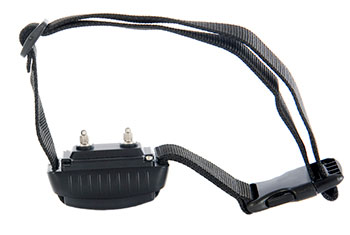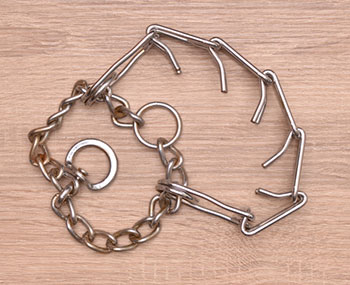Table of Contents
Key Takeaways
- Collars that hurt your dog, such as shock or prong collars, will damage your bond with your dog.
- If used incorrectly, some collars can physically harm your dog.
- Shocking your dog when they are expressing fear can result in a more anxious and confused dog, creating new behavior problems.
If you struggle to control a recently adopted dog while out on walks, it may be tempting to consider purchasing a prong or electronic “shock” collar. Some dog trainers will even recommend such collars.
But you should resist using collars that may physically hurt your dog and the bond you share. Despite what some dog trainers say, fear or pain-based training methods are not safe or humane.
Pain-based training methods damage trust

Punishment-based dog training methods usually involve training collars like shock collars (otherwise known as e-collars), bark collars, and prong collars.
While these methods may give short-term results, they can create behavioral issues, such as fear reactions, insecurity, and overall stress. These tactics can damage your relationship with your dog, as you are severing the bonds built on trust, and your dog will no longer feel safe with you.
Let’s face it, shock collars hurt. Their focus is to cause pain when your dog does an undesirable behavior. With so much awareness about animals and their sensitivities today, it’s time to start respecting dogs and treating them with kindness while they learn, rather than using painful tactics to try and control their behavior.
Disciplinary collars and why they are a problem:
Shock collars
 Most shock collars are battery-operated devices with a range of up to 500 feet that issue a shock from a remote controller when activated. Most have several types of enforcement and intensity levels, allowing the user to set the level of shock or choose a less jarring mode such as vibrate. Many shock collars will administer a beep or vibration or sound as a warning before an actual shock is delivered to the dog.
Most shock collars are battery-operated devices with a range of up to 500 feet that issue a shock from a remote controller when activated. Most have several types of enforcement and intensity levels, allowing the user to set the level of shock or choose a less jarring mode such as vibrate. Many shock collars will administer a beep or vibration or sound as a warning before an actual shock is delivered to the dog.
Besides training, some people have shock collars on their dogs and an electronic fence to prevent them from leaving the property. The seeming randomness (to the dog) of being shocked at the fence line will confuse them. Some dog owners reported their dog refused to go outside after training with it and started urinating in the house.
If you punish your dog for warning you that they are afraid with a shock collar, they may overreact, without warning, the next time they feel anxious or fearful. If they see another dog and are shocked for lunging or barking, the pain reinforces that dogs are to be feared because they are essentially being attacked every time they see another dog.
Some people think it’s OK to use a shock collar on the vibration or sound setting, but even that can cause anxiety, as it’s not a natural experience and is a reminder of the previous shock training.
Bark collars

Many people still use bark collars (another version of an e-collar), and some trainers recommend them. These are cruel, and when you understand a dog’s behavior and the reason behind their barking, it doesn’t make sense to use one.
When a dog barks to alert you that someone is at the door or someone is passing by your house, for example, they are essentially saying, “Danger, danger!” If they are shocked when they alert you that they think there’s a threat, imagine how confusing and stressful that can be for a dog.
They are alerting you of danger, then they get shocked, which just confirms that there is a threat. If they stop barking, it’s only because they are afraid of getting ‘attacked’ again, not because they aren’t concerned about the person walking past.
Bark collars can cause dogs to feel like they are walking on eggshells. It’s in a dog’s nature to want to protect their family, so they are triggered more intensely due to being shocked, which convinces them that the passerby is indeed a threat. They become more hyper-vigilant, then every time they get scared and let you know by barking, they are punished again, causing them more stress and overall anxiety.
Think of it this way, if your child told you that they heard someone breaking in, would you punish them for telling you? Or would you check it out and give them the comfort and security they needed?
Prong Collars
 Many trainers recommend prong collars to teach a dog how to heel. Prong collars (also known as pinch collars) have a series of fang-shaped metal links, or prongs, with blunted points that pinch the loose skin on a dog’s neck when pulled. This can cause possible damage to the windpipe, nerves, and other tissues.
Many trainers recommend prong collars to teach a dog how to heel. Prong collars (also known as pinch collars) have a series of fang-shaped metal links, or prongs, with blunted points that pinch the loose skin on a dog’s neck when pulled. This can cause possible damage to the windpipe, nerves, and other tissues.
These collars are harmful as they are used to correct unwanted behavior by inflicting pain as punishment.
Understanding your dog’s behavior
When a dog reacts intensely, like lunging, barking, or growling at another dog, it’s essential to realize they feel overwhelmed with fear and anxiety. This reaction is a natural response because they have no other way to show you they are scared.
It may appear as though this punishment-based approach is working because your dog stops the behavior, but it’s because they are afraid to react, not because they have changed how they feel when they see another dog.
It will also cause them to feel even more fearful as they learn to suppress their outward signs of fear. The fear doesn’t go away just because they don’t react. Now that fear will likely show up in different ways, for example, your dog not being able to settle down and seeming anxious all the time.
Imagine going on a walk with your family and seeing people who scared you, but not being able to even show that you are afraid, because you will be severely punished for your fear. Dogs deserve the same love, patience, and understanding that a child should be shown when they are afraid and struggling with intense emotion.
We can’t reason with dogs or explain what is happening because they don’t speak human, but we can effectively change their mind about the pet parent being responsible for the family’s safety, not them. The key is learning how to communicate with your dog in a way they understand so that when they feel nervous, you can show them they can trust you to always keep them safe.
Dogs who have suffered trauma
Suppose a dog has been attacked by another dog in the past or a person has mistreated them. In that case, their fear is genuine. Every time they see another dog/unfamiliar person that reminds them of the dog/person who attacked them, their intense reaction is equivalent to a person having a panic attack.
Some dogs can work through the trauma in a few months and can learn to feel safe around dogs or people again, while others are traumatized for life and need to be taken to more remote places to go on a walk to avoid triggers.
Building a foundation built on trust

Every dog responds differently to shock collars, bark collars, and prong collars. The more sensitive dogs tend to have more intense reactions of fear, anxiety, and insecurity after the use of a shock/bark/prong collar. Despite their response, every dog is adversely affected by their use.
They also don’t help your dog understand the desired behavior that you are trying to encourage. Studies have shown that positive, humane training is more effective than fear-based methods. People today want fast results, but it’s important to remember that the time and energy you spend helping your dog learn is quality time with your dog. You are developing a deep bond based on trust, and that foundation will help you and your dog for the rest of their life.
Wouldn’t you rather your dog learn how to have self-control through positive methods based on understanding them, instead of being afraid of you, dominated, and controlled?
Averse-based training not only causes more fearfulness and anxiety but reduces a dog’s ability to learn. When a dog is afraid and on edge, just waiting to be ‘attacked’ or punished, it can lead to behavioral issues, including an increased risk of what’s usually termed ‘aggression,’ growling at or biting family members and unfamiliar people. This is due to the breakdown of trust with people and the expectation they could be hurt and feel unsafe, even with their family members.
Recognition that shock collars are detrimental
Veterinarians and humane organizations have long recognized that punishment-based training can be detrimental to dogs. The number of organizations that accept that electronic shock collars are inhumane is growing. The American Veterinary Society of Animal Behavior (AVSAB), the Association of Professional Dog Trainers (APDT), the American Animal Hospital Association, the Humane Society of the United States, and the UK Kennel Club have all taken a stand against the use of electronic collars.
And they’ve been banned in Denmark, Norway, Sweden, Austria, Switzerland, Slovenia, Germany, Wales, Quebec, and parts of Australia.
The best collars or harnesses for training your dog

No-Pull Harness – There are many dog harnesses specially designed to reduce pulling and prevent choking. Harnesses are the safest option, especially for small dogs, puppies, and dogs who have slipped their collar. It’s important to do your research and find the best option for you and your dog. Some have two metal leash rings with a chest attachment clip to stop your dog from pulling on walks and a back clip which is great for casual walks, jogging, hiking, etc.
Gentle Leader – This option is helpful if your dog tends to constantly search for things to eat on the walk. It is also a comfortable and humane way to prevent your dog from pulling on the leash during walks. The head halter fits around your dog’s head and nose (similar to a horse’s halter). This prevents choking and reduces your dog’s urge to pull.
While special harnesses can help, it’s important to teach your dog how to heel. The best way to start training your dog not to pull on a leash is by teaching your dog to heel off-leash, in the comfort and safety of your home. Once your dog understands how to heel, then you can teach them how to walk nicely on the leash.
It’s best to start in your backyard, with fewer distractions, and when they can heel in your yard, then start heel training on a leash, close to home. By taking the time to teach your dog to heel you won’t need to use a special leash to stop their pulling because your dog will understand how to walk nicely beside you.
Sarah-Anne Reed is a holistic dog trainer, and owner of Pack Dynamics®. Her practice focuses on understanding and respecting dogs as a different species and honoring them as individual beings.
This article is copyrighted by Sarah-Anne Reed and Pack Dynamics®, and no reproduction of this article without the express permission of Sarah-Anne Reed is permitted.
Are you interested in the best ways to train your dog? Then you are a great candidate for dog or puppy insurance. Get a quote and make sure you’re covered for future injuries or illnesses.








